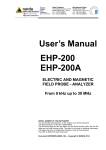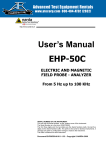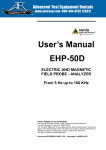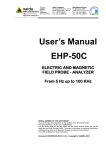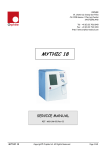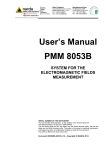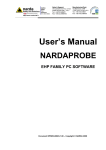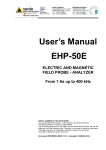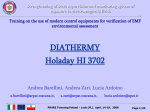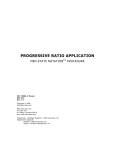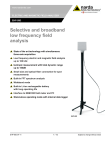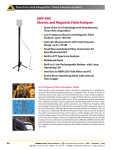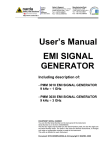Download User`s Manual EHP-200 EHP-200A
Transcript
NARDA Safety Test Solutions S.r.l. Socio Unico Sales & Support: Via Leonardo da Vinci, 21/23 20090 Segrate (MI) - ITALY Tel.: +39 02 2699871 Fax: +39 02 26998700 Manufacturing Plant: Via Benessea, 29/B 17035 Cisano sul Neva (SV) Tel.: +39 0182 58641 Fax: +39 0182 586400 http://www.narda-sts.it User’s Manual EHP-200 EHP-200A ELECTRIC AND MAGNETIC FIELD PROBE - ANALYZER From 9 kHz up to 30 MHz SERIAL NUMBER OF THE INSTRUMENT You can find the Serial Number on the bottom cover of the instrument. The Serial Number is in the form: 000XY00000. The first three digits and the two letters are the Serial Number prefix, the last five digits are the Serial Number suffix. The prefix is the same for identical instruments, it changes only when a configuration change is made to the instrument. The suffix is different for each instrument Document EHP200EN-01217-1.74 – Copyright © NARDA 2009 NOTE: ® Names and Logo are registered trademarks of Narda Safety Test Solutions GmbH and L3 Communications Holdings, Inc. – Trade names are trademarks of the owners. If the instrument is used in any other way than as described in this Users Manual, it may become unsafe Before using this product, the related documentation must be read with great care and fully understood to familiarize with all the safety prescriptions. To ensure the correct use and the maximum safety level, the User shall know all the instructions and recommendations contained in this document. This product is a Safety Class III instrument according to IEC classification and has been designed to meet the requirements of EN61010-1 (Safety Requirements for Electrical Equipment for Measurement, Control and Laboratory Use). In accordance with the IEC classification, the battery charger of this product meets requirements Safety Class II and Installation Category II (having double insulation and able to carry out mono-phase power supply operations).. It complies with the requirements of Pollution Class II (usually only non-conductive pollution). However, occasionally it may become temporarily conductive due to condense on it. The information contained in this document is subject to change without notice. KEY TO THE ELECTRIC AND SAFETY SYMBOLS: You now own a high-quality instrument that will give you many years of reliable service. Nevertheless, even this product will eventually become obsolete. When that time comes, please remember that electronic equipment must be disposed of in accordance with local regulations. This product conforms to the WEEE Directive of the European Union (2002/96/EC) and belongs to Category 9 (Monitoring and Control Instruments). You can return the instrument to us free of charge for proper environment friendly disposal. You can obtain further information from your local Narda Sales Partner or by visiting our website at www.narda-sts.it . Warning, danger of electric shock Earth Read carefully the Operating Manual and its instructions, pay attention to the safety symbols. Unit Earth Connection Earth Protection Equipotential KEY TO THE SYMBOLS USED IN THIS DOCUMENT: The DANGER sign draws attention to a potential risk to a person’s DANGER safety. All the precautions must be fully understood and applied before proceeding. WARNING The WARNING sign draws attention to a potential risk of damage to the apparatus or loss of data. All the precautions must be fully understood and applied before proceeding. CAUTION The CAUTION sign draws attention against unsafe practices for the apparatus functionality. NOTE: II The NOTE draw attention to important information. Note and symbols Contents Safety requirements and instructions…..........…….....……… EC Conformity Certificate…............................………………... Page VI VII 1 General information 1.1 Documentation......................................................….……... 1.2 Introduction ……………….....................…………………..… 1.3 Standard accessories.............................................……….. 1.4 Optional accessories ..............................................……..… 1.5 EHP-200 Main specifications............................................... 1.6 EHP-200 panel...................................………..……………… 1.7 EHP-200A Main specifications............................................. 1.8 EHP-200A panel....................................……..……………… Page 1-1 1-1 1-2 1-2 1-3 1-3 1-4 1-4 2 Installation and Use 2.1 Introduction……………………………………………………… 2.2 Preliminary Inspection…………………………………………. 2.3 Work environment……………………………………………… 2.4 To return for repair……………………………………………... 2.5 To clean the meter……………………………………………... 2.6 Installation of the EHP-200/A................................…...…….. 2.7 EHP200/A Battery management…………….....……...…….. 2.8 EHP200/A Power supply and battery charging……………... 2.9 Avoiding measurement errors………………………………… Page 2-1 2-1 2-1 2-1 2-1 2-2 2-3 2-3 2-4 3 EHP-TS Software 3.1 Introduction…………………………………………………..…. 3.2 Hardware requirements…………………………...………..…. 3.3 Installing EHP-TS Software………….………………..………. Page 3-1 3-1 3-2 4 USB-OC Installation 4.1 USB-OC Optical to USB Converter driver installation….…... 4.2 Hardware installation..................…………………………..…. 4.3 COM Port setting with 8053-OC……………………………… Page 4-1 4-5 4-6 5 Description 5.1 EHP-TS Applications………………………………………….. 5.2 EHP-200/A Applications…….....…………………………..…. 5.3 Main menù……………………………………………………... 5.3.1 Sweep section……………………………………………….. 5.3.2 Data section………………………………………………….. 5.3.3 Mode section……………………………………………….... 5.3.4 Limit section………………………………………………….. 5.3.5 Appearance section………………………………………….. Page 5-1 5-2 5-2 5-3 5-4 5-5 5-7 5-8 6 Update Firmware 6.1 Update firmware…………..……………………………………. 6.2 To run the update software..………………………………….. 6.3 To transfer data ……………………………………………….. Page 6-1 6-1 6-1 Contents III 7 Uninstalling software 7.1 Uninstalling EHP-TS Software ………………………..……… Page 7-1 8 Uninstalling USB-OC 8.1 Uninstalling driver for USB-OC……………..……………..…. Page 8-1 9 Accessories 9.1 Introduction………………….………………………………..... 9.1.1 Preliminary inspection……..…...…………………………… 9.1.2 Work environment….………………………………………... 9.1.3 Return for repair…………………………………………..…. 9.1.4 Cleaning…………………………………………………..….. 9.1.5 Power supply and battery chargers…………………….…. 9.2 USB-OC Optical USB Converter…………………………...... 9.2.1 Introduction…………………………………………………… 9.2.2 Installation………………………………………………….... 9.3 8053-OC Optical RS232 Converter…………………..…..…. 9.3.1 Introduction………………………………………………..…. 9.3.2 Installation…………………………………………….……… 9.4 8053-OC-PS Power Supply………….………………..…..…. 9.4.1 Introduction………………………………………………..…. 9.4.2 Installation…………………………………………….……… 9.5 8053 DISPLAY……………………………………….………… 9.5.1 Introduction……………………………………………….….. 9.5.2 Standard accessories………………………………….…… 9.5.3 Optional accessories…………………………………….….. 9.5.4 Main specification………………………………………...…. 9.5.5 Field probe….……………………………………………..…. 9.5.6 Front panel……………………………………………….…… 9.5.7 Side panel……………………………………………….……. 9.5.8 Battery charger…………………………………………..…… 9.5.9 To substitute the mains connector……………………..….. 9.5.10 To check the internal batteries………………………..….. 9.6 TR-02A Tripod……………………………………………........ 9.6.1 Introduction……………………………………………….….. 9.7 TT-01 Fiber glass Telescopic support……………….….…… 9.7.1 Introduction……………………………………………….….. 9.8 Other accessories………………………………………….….. Page 9-1 9-1 9-1 9-1 9-1 9-2 9-3 9-3 9-3 9-4 9-4 9-4 9-5 9-5 9-5 9-6 9-6 9-6 9-6 9-7 9-8 9-9 9-9 9-10 9-10 9-10 9-11 9-11 9-13 9-13 9-14 10 Software command protocol 10.1 Introduction……………………………....................……….. 10.2 Input select commands……………………………………… 10.3 Setting command…………………………….…………….... 10.4 Data request command………………………………..……. 10.5 SWEEP Commands…………………………………………. Page 10-1 10-2 10-3 10-3 10-4 IV Contents Figures Figure 1-1 1-2 2-1 2-2 3-1 4-1 4-2 4-3 5-1 6-1 7-1 8-1 9-1 9-2 9-3 9-4 9-5 9-6 9-7 Page EHP-200 panel ........………...............…………… EHP-200A panel ........………...........……………. EHP-200 Battery Discharging…………………… EHP-200A Battery Discharging…………………. EHP-TS Installation……………………………….. USB-OC converter………………………………… EHP-200/A link with USB-OC……………………. EHP-200/A link with 8053-OC……………..….…. EHP-200 EHP-TS Main Window………………… EHP200 Upgrading Utility Main Window……….. Uninstalling EHP-TS……………………………… Uninstalling USB-OC……………………………… USB-OC Adapters………………………………… 8053-OC Panels…………………………………… 8053-OC-PS Connectors…………………………. 8053 DISPLAY Front Panel………………………. 8053 DISPLAY Side Panel…….…………………. TR-02A Tripod…..……………………….………… TT-01 Fiber Glass Telescopic Support…………. 1-3 1-4 2-3 2-3 3-2 4-1 4-5 4-5 5-2 6-1 7-1 8-2 9-3 9-4 9-5 9-9 9-9 9-11 9-13 Tables Table 1-1 2-1 2-1 9-1 9-2 9-3 9-4 9-5 9-6 9-7 Page Technical Specifications of the EHP-200….….... Technical Specifications of the EHP-200/A.….... Led colour EHP-200/A……….………………….... Technical Specifications of the USB-OC……….. Technical Specifications of the 8053-OC……….. Technical Specifications of the 8053-OC-PS…… Technical Specifications of the 8053 DISPLAY… Series of electric and magnetic field probe…….. Technical Specifications of the TR-02A….……… Technical Specifications of the TT-01…………… 1-3 1-4 2-2 9-3 9-4 9-5 9-7 9-8 9-11 9-13 Contents V SAFETY RECOMMENDATIONS AND INSTRUCTIONS This product has been designed, produced and tested in Italy, and it left the factory in conditions fully complying with the current safety standards. To maintain it in safe conditions and ensure correct use, these general instructions must be fully understood and applied before the product is used. • When the device must be connected permanently, first provide effective grounding; • If the device must be connected to other equipment or accessories, make sure they are all safely grounded; • In case of devices permanently connected to the power supply, and lacking any fuses or other devices of mains protection, the power line must be equipped with adequate protection commensurate to the consumption of all the devices connected to it; • In case of connection of the device to the power mains, make sure before connection that the voltage selected on the voltage switch and the fuses are adequate for the voltage of the actual mains; • Devices in Safety Class I, equipped with connection to the power mains by means of cord and plug, can only be plugged into a socket equipped with a ground wire; • Any interruption or loosening of the ground wire or of a connecting power cable, inside or outside the device, will cause a potential risk for the safety of the personnel; • Ground connections must not be interrupted intentionally; • To prevent the possible danger of electrocution, do not remove any covers, panels or guards installed on the device, and refer only to NARDA Service Centers if maintenance should be necessary; • To maintain adequate protection from fire hazards, replace fuses only with others of the same type and rating; • Follow the safety regulations and any additional instructions in this manual to prevent accidents and damages. VI Safety Consideration EC Conformity Certificate (in accordance with the Directives: EMC 89/336/EEC and Low Voltage 73/23/EEC) This is to certify that the product: EHP-200 Electric and Magnetic field Probe - Analyzer Produced by: NARDA S.r.l. Safety Test Solution Via Benessea 29/B 17035 Cisano sul Neva (SV) – ITALY complies with the following European Standards: Safety: CEI EN 61010-1 (2001) EMC: EN 61326-1 (2007) This product complies with the requirements of the Low Voltage Directive 2006/95/CE and with the EMC Directive 2004/108/CE. NARDA S.r.l.. EC Conformity Certificate (in accordance with the Directives: EMC 89/336/EEC and Low Voltage 73/23/EEC) This is to certify that the product: EHP-200A Electric and Magnetic field Probe - Analyzer Produced by: NARDA S.r.l. Safety Test Solution Via Benessea 29/B 17035 Cisano sul Neva (SV) – ITALY complies with the following European Standards: Safety: CEI EN 61010-1 (2001) EMC: EN 61326-1 (2007) This product complies with the requirements of the Low Voltage Directive 2006/95/CE and with the EMC Directive 2004/108/CE. NARDA S.r.l.. EC Conformity VII This page has been left blank intentionally VIII Safety Consideration 1 - General information 1.1 Documentation Enclosed in this manual: • service questionnaire to send back to NARDA • check list of accessories enclosed in packaging. 1.2 Introduction EHP-200/A E-H fields analyzer has been designed for accurate measurements of both electric (0,02 to 1000 V/m) and magnetic (6 mA/m to 300 A/m) fields, in the frequency range 9 kHz to 30 MHz. Both the field sensors and the electronic measuring circuitry are accommodated in a robust housing, only 92x92x109 mm in size. Measurements are given separately for the 3-axis, or total value (peak and average), with exceptional flatness and linearity. Results are expressed in V/m, A/m, microT, mG, mW/cm2, W/m2 and % of a selected limit. The EHP-200/A features built- in spectrum analysis with minimum resolution of 1 kHz for detailed measurements of the E and H field intensity vs. frequency over a great dynamic range of 80 dB. The power supply is provided by an internal Li-Ion battery for up to 8 hours (EHP-200) or 12 hours (EHP-200A) of continuous operation, or from an external 10-15 V DC source by an AC adapter. The EHP-200/A is controlled by a PC-based program, and measurements are transmitted in real time through a optical fiber link. An auxiliary input allows for measuring the frequency spectrum of external signals from any other RF device. Thanks to it very small size and to the optical fiber link, the EHP-200/A does not influence the electromagnetic fields under measure, thus ensuring more accurate and sensitive measurements. Therefore the EHP-200/A is particularly suitable for nearby measurements of LW-AM-SW bands transmitters, metal detectors, and any other application requiring measurements of RF signals in the 9 kHz – 30 MHz range, with great advantage wherever the conventional antennas are inadequate due to their physical dimensions, and cable influence must be prevented. EHP-200/A is housed in a small cubic case. Bottom: optical fiber connector, extension rod screw, battery charger connector, auxiliary RF input, ON/OFF button and operation LED. The magnetic sensor system is composed by three orthogonal magnetic loops. The electric sensor system is composed by three orthogonal parallel capacitors installed on opposite side of the magnetic loops. Document EHP200EN-01217-1.74 - © NARDA 2009 General Information 1-1 1.3 Standard accessories Standard accessories included with EHP-200/A: • 8053-SC Soft carrying case, holds basic unit and accessories including 8053-Display (650.000.035); • AC/DC battery charger (650.000.036); • International AC plug adapter (UK:650.000.037, USA:650.000.038, Australia:650.000.039, Italy:650.000.040); • FO-8053/10 Cable, fiber optic 10m (650.000.053) • FO-10USB Cable, fiber optic 10m (650.000.177); • USB-OC Optical-USB converter (650.000.176); • Plastic rod support, 50cm (231.800.012); • Mini tripod, bench top (650.000.151); • EHP-TS software, CD-ROM; • Operating Manual; • Certificate of calibration; • Return for Repair Form. 1.4 Optional accessories The following accessories can be ordered separately: • • • • • • • • • • • • 8053-OC Optical RS232 converter (650.000.062); 8053-OC-PS Power Supply (650.000.179); FO-8053/20 Cable, fiber optic 20 m (650.000.055); FO-8053/40 Cable, fiber optic 40 m (650.000.052); FO-8053/80 Cable, fiber optic 80 m (650.000.128); FO-20USB Cable, fiber optic 20 m (650.000.178); FO-40USB Cable, fiber optic 40 m (650.000.182); TR-02A wooden tripod 1-2m with soft carrying bag (655.000.005); TT-01 telescopic mast (120-420 cm) with carrying bag (650.000.005) 8053-Display display unit (620.000.057) 8053-CA car adapter (650.000.058) 8053-CC rigid case (650.000.059) Updates of the software and firmware of the EHP-200/A can be downloaded from the Web site www.narda-sts.it or requested directly from NARDA Sales Centers. 1-2 General Information 1.5 EHP-200 Main specifications The following conditions apply to all specifications: • Operating ambient temperature must be between -10°C and 50° C. Table 1-1 Technical specifications of the EHP-200 Electric and Magnetic Field Analyzer Electric Field 9 kHz ÷ 30 MHz Magnetic Field Mode A 9 kHz ÷ 3 MHz Magnetic Field Mode B 300 kHz ÷ 30 MHz AUX Input 9 kHz ÷ 30 MHz @10kHz RBW 0,1 ÷ 1000 V/m 30 mA/m ÷ 300 A/m 3 mA/m ÷ 30 A/m -80 ÷ 0 dBm with preamplifier ON 0,02 ÷ 200 V/m 6 mA/m ÷ 60 A/m 0.6 mA/m ÷ 6 A/m -94 ÷ -14 dBm Frequency range Measurement range Dynamic range Measurement range Resolution Sensitivity @10kHz RBW (*) 0.01 V/m 0.1 V/m 1 mA/m 30 mA/m 0.1 mA/m 3 mA/m 0.01 dB -80 dBm with preamplifier ON 0.02 V/m 6 mA/m 0.6 mA/m -94 dBm 0,5 dB 0,8 dB 150 kHz – 3 MHz 0,8 dB 300 kHz – 27 MHz @ -20dBm @ 166 mA/m @ 53 mA/m Flatness > 80 dB > 94 dB 100 kHz – 27 MHz @ 20 V/m Anisotropicity @1MHz Linearity @1MHz SPAN RBW Rejection to E fields Rejection to H fields Calibration Temperature error Dimensions Weight --> 20 dB 0,4 dB 0.8 dB 0,5 dB from FS to –60 dBFS 0 to FULL SPAN 1 kHz – 3 kHz – 10 kHz – 30 kHz – 100 kHz – 300 kHz > 20 dB --2 internal E PROM 0,02 dB/°C 92 x 92 x 109 mm 550 g --- ----- selectable ON/OFF, 14dB V/m, A/m, uT, mW/cm2, W/m2 3,7 V – 3,6 Ah Li-Ion, rechargeable > 8 hours < 8 hours 10 ÷ 15 VDC, I = approx. 500 mA up to 40 m (USB-OC) up to 80 m (8053-OC) through the optical link Firmware updating automatic at power on Self test -10 to +50°C Operating temperature -20 to +70°C Storage temperature (*) The maximum sensitivity is achieved with the filter to 10 kHz Preamplifier Units Internal battery Operation Recharging time External supply Optical fiber connection 1.6 EHP-200 Panel Key: 1. Led 2. Battery charger connector 3. ON/OFF button 4. AUX input connector MMCX male type Fig. 1-1 EHP-200 Panel 5. Fiber optic connector General Information 1-3 1.7 EHP-200A Main specifications The following conditions apply to all specifications: • Operating ambient temperature must be between -10°C and 50° C. Table 1-2 Technical specifications of the EHP-200A Electric and Magnetic Field Analyzer Electric Field 9 kHz ÷ 30 MHz Magnetic Field Mode A 9 kHz ÷ 3 MHz Magnetic Field Mode B 300 kHz ÷ 30 MHz AUX Input 9 kHz ÷ 30 MHz @10kHz RBW 0,1 ÷ 1000 V/m 30 mA/m ÷ 300 A/m 3 mA/m ÷ 30 A/m -80 ÷ 0 dBm with preamplifier ON 0,02 ÷ 200 V/m 6 mA/m ÷ 60 A/m 0.6 mA/m ÷ 6 A/m -94 ÷ -14 dBm Frequency range Measurement range > 80 dB > 94 dB Dynamic range Measurement range Resolution Sensitivity @10kHz RBW (*) 0.01 V/m 0.1 V/m 1 mA/m 30 mA/m 0.1 mA/m 3 mA/m 0.01 dB -80 dBm with preamplifier ON 0.02 V/m 6 mA/m 0.6 mA/m -94 dBm 0,5 dB 0,8 dB 150 kHz – 3 MHz 0,8 dB 300 kHz – 27 MHz @ -20dBm @ 166 mA/m @ 53 mA/m Flatness 100 kHz – 27 MHz @ 20 V/m Anisotropicity @1MHz Linearity @1MHz SPAN RBW Rejection to E fields Rejection to H fields Calibration Temperature error Dimensions Weight --> 20 dB 0,4 dB 0.8 dB 0,5 dB from FS to –60 dBFS 0 to FULL SPAN 1 kHz – 3 kHz – 10 kHz – 30 kHz – 100 kHz – 300 kHz > 20 dB --2 internal E PROM 0,02 dB/°C 92 x 92 x 109 mm 580 g --- ----- selectable ON/OFF, 14dB V/m, A/m, uT, mW/cm2, W/m2 3,7 V – 5,55 Ah Li-Ion, rechargeable > 12 hours < 8 hours 10 ÷ 15 VDC, I = approx. 560 mA up to 40 m (USB-OC) up to 80 m (8053-OC) through the optical link Firmware updating automatic at power on Self test -10 to +50°C Operating temperature -20 to +70°C Storage temperature (*) The maximum sensitivity is achieved with the filter to 10 kHz Preamplifier Units Internal battery Operation Recharging time External supply Optical fiber connection 1.8 EHP-200A Panel Key: 1. Led 2. Battery charger connector 3. ON/OFF button 4. AUX input connector MMCX male type Fig. 1-2 EHP-200A Panel 1-4 General Information 5. Fiber optic connector 2 – Installation and Use 2.1 Introduction This section provides the information required for installing and using the EHP-200/A Analyzer. Information is included regarding initial inspection, power requirements, interconnections, work environment, assembly, cleaning, storage and shipment. 2.2 Preliminary inspection Inspect the packaging for any damage. If the packaging or anti-shock material have been damaged, check that the contents are complete and that the meter has not suffered electric or mechanical damage. Check that all the Accessories are there against the checklist found with the apparatus. Inform the carrier and NARDA of any damage that has occurred. 2.3 Work environment The work environment of the Accessories, must come within the following conditions: From -10°C to +50°C • Temperature < 90% relative • Humidity The meter must be stored in a clean and dry environment, free from acid dusts and humidity. The storage environment must come within the range of the following conditions: From -20°C to + 70°C • Temperature < 95% relative • Humidity 2.4 To return for repair When the meter needs to be returned to NARDA for repair, please complete the questionnaire appended to this User’s Manual, filling in all the data that will be useful for the service you have requested. For reducing the period of time required for the repairs, it is necessary to be as specific as possible in describing the problem. If the problem only occurs in certain circumstances, please describe in detail how it happens. If possible it is better to reuse the original packaging; making sure that the apparatus is wrapped in thick paper or plastic. Otherwise, use strong packaging by using a sufficient quantity of shock absorbent material around all sides of the meter to ensure that it is compact and does not move around inside the package. In particular, take every precaution to protect the front panels. Finish the package by sealing it up tightly. Apply a FRAGILE label to the package to encourage greater care in its handling. 2.5 To clean the meter Use a dry, clean and non-abrasive cloth for cleaning the meter. Do not use solvents, acids, turpentine, acetone or other similar products for cleaning the meter in order to avoid damaging it. 1 Document EHP200EN-01217-1.74 - © NARDA 2009 Installation and Use 2-1 2.6 Installation of the EHP-200/A To install EHP-200/A, connect the supplied fiber optic to the OPTIC LINK connector taking care that the spigot matches the housing. Connect the other end of the fiber optic to the OPTIC LINK connector of the USB-OC or 8053-OC. Connect the converter to a port of the PC. Do not pull the fiber optic by holding onto the cable but use the connector so that the head does not get damaged. Avoid dirt and other particles getting into the transducers of the fiber optic. The fiber optic of the EHP-200/A Analyzer can be disconnected and reconnected while in use. In this case, communication will be restarted automatically. Turn on EHP-200/A by pushing the Red POWER button for one second. Run EHP-200 control software. Communication with PC is shown by the blinking green LED. EHP-200/A must be ON before running EHP-200 control software. EHP200/A may not be correctly recognized if switched ON when the control software is already running. Pressing the POWER down button for more than 4 seconds forces the hardware of the apparatus to shut down. Then, it is necessary to wait several seconds before switching it on again. When switched on, the three-color ON DATA LED will provide the following information: After switching on the analyzer, the ORANGE LED lights up for about ½ second as an auto-check, after that the Green light starts blinking which means that the firmware has been correctly downloaded. Blinking speed Changes depending on the SPAN Medium FIX Off TABLE 2-1 Led colour Colour of the LED Meaning Green Communication with PC in progress and correct Red Green Off PC disconnected or error in communication Recharging battery Battery recharging completed The EHP-200/A can be switched off manually by pressing the Red POWER button. If the attempt to communicate is not successful or if the fiber optic is not connected to the PC, the EHP-200/A will automatically switch off after about 30 minutes to preserve the battery charge. 2-2 Installation and Use 2.7 EHP200/A Battery management EHP-200/A features an efficient control of the Li-Ion internal battery. The picture below shows the typical discharging curve of EHP200: Fig. 2-1 EHP-200 Battery Discharging The picture below shows the typical discharging curve of EHP200A; Fig. 2-2 EHP-200A Battery Discharging Installation and Use 2-3 2.8 EHP200/A Power supply and battery charging EHP-200/A has an internal rechargeable Li-Ion battery to be recharged by the supplied battery charger (the battery charger is the same as that of 8053 DISPLAY). The charge of the probe, must come within the following conditions: From 0°C to +35°C • Temperature < 90% relative • Humidity Make a full charging cycle before using the Analyzer for longest battery operation time. It is recommended to connect the battery charger to the AC mains BEFORE connecting it to the EHP-200/A. The battery charger has an internal output current limiter in case of overload when connecting to the mains. Battery charger for EHP200: output: DC, 10 - 15 V, ~ 500 mA Connector: - + Battery charger for EHP200A: output: DC, 10 - 15 V, ~ 560 mA Connector: - + The minimum voltage level for operation is 3.25V. Under this battery voltage the analyzer will turn OFF automatically and the battery must be charged. Charging time is of 4-5 hours. Battery recharging is indicated when the Led of EHP-200/A is green. When the charge is complete the led turns off. The battery status is reported by the EHP-200 control program When charging is in progress the operator is warned in the battery subwindow. 2-4 Installation and Use 2.9 Avoiding measurement errors To avoid disturbing the measurements in progress, the user or other People or mobile vehicles should stay at least 5 meters away from the EHP-200/A Analyzers. We also recommend that the probe be set up far from metal objects or masses. To perform correct measurements, the tripod TR-02A to hold EHP200/A is reccomended. Using an unsuitable support could influence the measurements thus giving incorrect results. We recommend always using the supplied isolated extension rod together with the TR-02A optional tripod to positioning the EHP-200/A at the height stated by the reference standards for the measurement in progress. Use the same configuration to ensure the measurements taken can be repeated. The intensity of the measured field mainly depends on its voltage and the geometry of the system under analysys, as well as on the distance between the conductors and the measurement points. In proximity of the cables the field value reading may be very high and will vary according to the location of the probe. From the definition of the potential difference between two points: r2 = − V 21 ∫ E dr r1 It is evident that, keeping the potential difference constant as the distance between the two points under examination decreases, the intensity of the field necessarily increases. E.g.: the electric field intensity between two armatures of a parallelplate capacitor situated at a distance of 0.1 m and having a potential difference of 100 V is equal to: E= 100V = 1 KV m 0,1m It should be noted that a voltage of 100 V, in these conditions, generates a field of 1000 V/m. It is, therefore, possible, in the vicinity of 220 V conductors, that there may be a field which is much higher than 220 V/m. Installation and Use 2-5 This page has been intentionally left blank 2-6 Installation and Use 3 – EHP-TS software 3.1 Introduction EHP-TS is a useful software tool developed for remote PC control, through fibre optic link, of EHP family Electromagnetic field analyzers. By means of the recently introduced USB-OC optical to USB converter, EHP-50C and EHP-200/A can be connected to a PC USB port. Using the former optical/RS232 adapter, the selected COM port should be assigned to the application software (see cap.5 EHP-TS applications). EHP-TS software requires that at least one of the mentioned analyzers is connected to PC in order to run. The EHP-TS installation program doesn’t install any driver for USB-OC converter but makes the driver file available for its installation. 3.2 Hardware requirements Minimum requirements: • • • • • 486 Processor or Pentium 16 Mb RAM At least 2 Mb of free space on hard disk 1 free USB or RS232 port Windows Operating system™ XP/Vista/Win7 1 Document EHP200EN-01217-1.74 - © NARDA 2009 NardaProbe software 3-1 3.3 Installing EHP-TS Software Before connecting the EM field analyzer to PC the EHP-TS software installation should be performed: Insert the EHP-TS CD into the driver of your PC and run the file “EHP-TS Setup.exe”. Follow set-up program instructions Fig.3-1 EHP-TS installation 3-2 NardaProbe software NardaProbe software 3-3 When asked for, reboot your system to complete installation EHP-TS software is now installed in your PC, you can remove it, if needed, simply running the “Uninstall EHP-TS” application. (see cap.7) 3-4 NardaProbe software 4 – USB-OC Installation 4.1 USB-OC optical to USB converter driver Installation USB-OC optical to USB converter requires a driver program to be installed in your system. EHP-TS software creates a folder including all files requested for the driver installation. Before running EHP-TS, please connect the USB-OC converter to a USB port of your PC. Fig.4-1 USB-OC Converter The following provides, as an example, USB converter installation instructions for Windows XP O.S. The procedure to select location of the driver directory will be different in case of different operating systems In case the driver is not already installed, a message informing that new hardware has been found will be shown and a guided installation will start: Do not allow connection to Windows Update but select “No, not now” and click “next” 1 Select “Install from a list or specific path” and click “next” Document EHP200EN-01217-1.74 - © NARDA 2009 USB-OC Installation 4-1 Select options as in the previous picture and click “browse” to select the directory containing the requested files: The folder “USB-WIN-98” includes driver for Windows 98. The folder “USB-WIN-XP” includes driver for Windows XP and Vista. The folder “WIN-7” includes driver for Windows 7. You can find the folders in the following C:\Programs\NardaSafety\EHP-TS, select it and click “OK” Click “next” to start installation. 4-2 USB-OC Installation path: Click “continue” It may happen that a more recent version of a requested file is already present in your system. In this case do not replace it but answer “No” to the confirmation request: USB-OC Installation 4-3 In case of Windows XP operating system the entire procedure will be executed twice as two different drivers will be installed. Same steps as above should be followed and same path C:\Programs\NardaSafety\EHP-TS must be selected. Click “Finish” to complete driver installation, the new hardware is now ready to be used. USB-OC converter driver is now installed in your PC, you can remove it, if needed, following instructions in cap.8. 4-4 USB-OC Installation 4.2 Hardware installation Connect the USB-OC supplied with EHP-200/A to a USB port of the PC, and the optic fiber cable to the EHP-200/A. Instead if you connect the probe to the RS232 port, you must use the optional accessories 8053-OC. Do not pull the optic fiber by holding onto the cable but use the connector so that the head does not get damaged. Avoid dirt and other particles getting into the transducers of the optic fiber. Fig. 4-2 EHP-200/A link with USB-OC Fig. 4-3 EHP-200/A link with 8053-OC EHP-200/A should be OFF. USB-OC Installation 4-5 4.3 COM Port setting with 8053-OC The optional accessory 8053-OC optical/RS232 adapter can be used to connect EHP-200/A to PC allowing thus 80 m maximum fibre length. With 8053-OC the program automatically establishes the connection on the first RS232 port that is not in use at that time, in the following order: COM1, COM2, COM3, etc. The energy available on the DB9 connector of some PC model could be not sufficient to guarantee a good link with 80 meter fibre. The energy available on the DB9 connector of some PC model could be not sufficient to guarantee a link with 8053-OC. In this case, is necessary use 8053-OC-PS between the converter and PC. (for more information see Accessories). Whenever a port is tied up by a device which is not active or turned off at that time, the program recognises it as free and will therefore attempt to connect EHP-200/A to that port. In this case, it is necessary to “force” the next serial port by the following procedure: • Click right the requested program icon and select “properties”. 4-6 USB-OC Installation • Add the command COMM=N preceded by a space (in capital letters) at the end of the Destination field where N indicates the serial port to be used; for example, if the EHP200/A is connected to port 2, add the command COMM=2. The assigned COM port nr. must be between 1 and 9. • In some operating system the Destination field is enclosed in double quotation marks (“); in this case, the command COMM=N, preceded by a space must be outside as in the example below; • • Then confirm by selecting Apply After switching the analyzer ON, run the control software. EHP-200/A must be ON before running EHP-200 control software. EHP-200/A may not be correctly recognized if switched ON when the control software is already running. USB-OC Installation 4-7 This page has been intentionally left blank 4-8 USB-OC Installation 5 – Description 5.1 EHP-TS applications EHP-TS software includes different applications to be used with EHP family analyzers. Shortcuts are shown, selecting “all programs” from the windows XP “start” button or, using Windows Vista or 7, by clicking Windows ( and Programs:: ) The EHP-50 section includes three different applications: EHP50C – Stand Alone Mode: main task of this program is to set up EHP50C for standalone mode. The analyzer will take and log E or H field measurements (according to the setting) for up to 24 hours, when switched on without any connection to external devices (see operating manual for details). Using EHP-50C Stand Alone mode program is then possible to download measurement results and store them as a text file. EHP50-TS: this program is used to perform live Spectrum Analysis measurements when an EHP-50C analyzer is connected to PC EHP-50 Update Firmware: this is a tool to update EHP-50C firmware The EHP-200 section includes two applications: EHP200-TS: this program is used to perform live Spectrum analysis measurements when an EHP-200/A analyzer is connected to PC EHP-200 Update Firmware: this is a tool to update EHP-200/A firmware 1 This document describes applications for EHP-200/A analyzer only. Document EHP200EN-01217-1.74 - © NARDA 2009 Description 5-1 5.2 EHP200-TS Application This chapter describes controls and function provided by EHP200-TS application for spectrum analysis included in EHP-TS software package. Connect EHP-200/A to the USB port of your PC using provided optical fibre and USB-OC optical to USB converter. Optional 8053-OC optical to RS232 converter can be used, as an alternative, to connect the analyzer to the PC RS232 connector. 5.3 Main menu Switch the analyzer ON and run EHP200-TS application. After the welcome screenshot appears for few seconds the program main window will be shown: Fig.5-1 EHP200 EHP-TS Main Window Description: 1 – EHP200 software release (communication port) 2 – Shows frequency while scanning 3 - Click “?” to display Serial Number, EHP-50C analyzer Firmware release and Date of calibration of EHP-200/A analyzer. 4 – trace of selected Limit 5 – EHP-200/A analyzer battery status 6 – Scan activation for each axis (default setting: all axis activated) 7 – Hold When Done: stops scan to allow data analysis as soon as all axis have been measured 8 - Show X-Y-Z: to display or not the traces of single axis. 9 – Acquisition mode selected (see Mode section) 10 – Exit button to terminate application 11 – Control panel 12 – Display for spectrum analysis 5-2 Description Commands are grouped in the control panel in 5 different sections: Sweep: to set sweep parameter and Resolution Bandwidth Data: to display measurement results and save data Mode: to set different operating modes Limit: to create and save limit traces, to activate a specific limit Appearance: to change colour and button aspect Each section can be activated with a mouse click. Description 5-3 5.3.1 Sweep section EHP-200/A does not include an FFT analyzer but a powerful receiver in the 9kHz – 30MHz frequency range. The sweep section includes the following controls: Start, Stop, Center, Span: to easily set, as in any spectrum analyzer, the frequency sweep parameters. Full Span button: to quickly set the frequency sweep parameters from 0Hz to 30MHz. Even if in this condition the graphical representation includes frequencies below the minimum operating range (9kHz), it shows round values on each division of the vertical grid. Full Range button: to quickly set the frequency sweep parameters from 9kHz to 30MHz (full frequency range) RBW: six different settings for the Resolution Bandwidth filter. This setting affects the sweep time (the higher RBW, the faster sweep) and frequency resolution (Lower RBW shows more details in the frequency axis) When the RBW is set to Coupled the filter width is set automatically depending on the sweep setting Depending on the Sweep – Start setting, the RBW filter should be set as narrow as enough to avoid the spectrum analyzer 0Hz signal to be included in the displayed spectrum when an integration over the frequency range has to be performed. Right click and drag on the graph window to define graphically the Zoom frequency range. 5-4 Description 5.3.2 Data section Measurement result: the following values are showed in a table form: Highest Peak: Maximum value within the displayed spectrum. Showed parameters: Highest Peak field strength in the selected Unit (V/m in the above picture) Highest Peak frequency (Hz) % of contribution to the WideBand result Marker: you can place a marker anywhere on the spectrum display with a mouse click Showed parameters: Field strength at Marker frequency in the selected Unit (V/m in the above picture) Marker frequency (Hz) % of contribution to the WideBand result Delta: Difference in Field strength (expressed in dB) and frequency (Hz) between Highest Peak and Marker WideBand: integration over the displayed frequency band Showed parameters: Field strength in the selected unit calculated over Bandwidth (Hz) Marker: in this area you can select on which trace to place the Marker: specific axis (X,Y,Z) or Total result. Traces of single axis can be displayed or not according to Show X-Y-Z command. Three buttons in this area to easily position marker over peaks, a dedicated button, Marker Center, to change automatically sweep parameters in order to obtain, as center frequency, the actual marker position. If activated, Limit checkbox allows displaying of the Limit value corresponding to the Marker frequency. Save: three buttons in this area to save spectrum as a picture file (.bmp), as a text file (.txt) or to copy the spectrum picture to the Windows Clipboard. Description 5-5 5.3.3 Mode section Acquisition: spectrum is displayed in different acquisition modes. Free Scan: instantaneous values are showed. RMS over 6 min: square averaging calculated over 6 minutes time period as requested by several regulation for high frequency field measurement. RMS over: square averaging calculated over the specified time period (sec) is showed. Max Hold: the maximum field strength value of each frequency step is retained and displayed since the Max Holf function has been activated. Input/Range: to select electric field, magnetic field in two different ranges, auxiliary input (50 Ohm input connector) and dual field mode in two different ranges. Move the mouse cursor over “Magnetic” to display frequency range and level range of “Mode A” and “Mode B”. Preamplifier: for best sensitivity when activated (vertical range changes accordingly). Linear Span or Logarithmic Span: this is used to select the linear or logarithmic frequency scale. Unit: to select unit according to the Input setting. Unless a Dual mode has been selected, Power density units are correlated ones assuming measurement to be performed in far field condition. Power density units in Dual mode are calculated from both electric and magnetic field measurements (no correlated units included in the calculation) and therefore valid in both far field and near field condition. The unit “%” can be selected only if a Limit has been activated. Each spectrum line will then represent the field strength expressed as percent of the selected limit. Z wave button: it can be selected only after complete scan in Hold When Done mode. The selected input must be Magnetic (mode A or B). When selected, the Zwave button shows the following display. 5-6 Description It represents the 3 axis and total E and H field strength at the marker frequency. The marker frequency is displayed in the upper position of the right column (0.0250 MHz in the previous picture). The wave impedance (in this case 5 Ohm) is the ratio between Electric and Magnetic field at the marker frequency. It is used for evaluations in near field condition. To prevent measurement errors the wave impedance is obtained by at frequencies where both the fields are at least 10dB the ratio above the noise floor of the instrument. Back to Scan button: to close the wave impedance display and switching back to the control panel. Description 5-7 5.3.4 Limit section Limit section allows the user to select standard ICNIRP limits, already included by the software installation, as well as user’s limits which can be created through the “Make Limit” function provided by this section. Default: The default limit section can be used to load a default standard limit saved into the memory at the factory. Default limit list shows limits which are compatible to the actual setting only. If Electric field was selected in the Mode section, electric field limits only are displayed by the limit list. No default limit is shown in case mG unit was selected. User Defined: This limit section allows to select and activate a specific limit among limits created and saved by the user. The Make Limit button opens a window to edit limits and create new ones. Type frequency and field strength for each point of the required limit and click save to save it under the program directory. The limit file will be created as a linear interpolation between specified points. 5-8 Description 5.3.5 Appearance section: Button and label style can be selected from a Style list Start and End Color button allow selection from a color palette Sample Button and Sample Label show the appearance preview Default button to set appearance to the default parameters Trace to set trace colours by means of the colour palette Description 5-9 5.4 Additional functions provided by EHP200-TS EHP-200A electromagnetic field analyzer provides Electric and Magnetic field selective measurement in the 9kHz – 30MHz frequency range. Even though there is no difference from EHP-50C/D regarding minimal physical overall dimensions and sensor positioning, a high frequency selective receiver is housed within this product. Additional settings and functions are therefore available. Regarding settings, Span can be set as desired within the entire frequency range and required RBW filter can be selected down to 1kHz allowing thus optimum selectivity. As requested by reference standards, Average value can be automatically calculated over 6 minutes as well as over customer definable time periods. An important advantage, which is provided thanks to the Dual (E and H), Tri-axial sensor technology implemented in EHP-200A is the new concept of power density calculation which, unlike common practice, makes use of both E and H real measurements providing thus accurate results which are still valid in both Near and Far Field conditions. Fig.5-2 Both electric and magnetic fields can be displayed on the same graph. Fig.5-3 Power density spectrum is calculated over real electric and magnetic field measurement and therefore applicable to both far and near field conditions. 5-10 Description New wave impedance function is provided too by selecting the Ohm unit. This function automatically searches and displays result at frequencies showing effective field ratio calculation. Fig.5-4 New wave impedance function To prevent measurement errors the wave impedance is obtained by at frequencies where both the fields are at least 10dB the ratio above the noise floor of the instrument. Description 5-11 This page has been intentionally left blank 5-12 Description 6 – Update Firmware 6.1 Update firmware The EHP-200/A internal firmware can be updated easily by the user itself. This section provides all the information required for firmware updating. The Update Firmware Program is available after EHP-TS package installation. 6.2 To run the update software Turn off the EHP-200/A and connect it to a free USB or RS232 port of the PC. Run EHP-200 Update Firmware to start the update program. 6.3 To transfer data Main window displayed after the updating program EHP-200 Update Firmware has been run: Fig.6-1 EHP-200 Upgrading Utility Main Window Select USB or RS232 communication port. Before selecting RS232 port, choose the COM port used. In case the software doesn’t detect any EHP-200/A in the USB port, the following message will be displayed. 1 Document EHP200EN-01217-1.74 - © NARDA 2009 Update Firmware 6-1 As soon the connection is established, the program is ready to update EHP200/A firmware. To start the process simply switch EHP-200/A on and wait (few minutes) until the automatic transfer is completed. 6-2 Update Firmware At the end, if the update has been successfully performed, the following window will appear: Turn the EHP-200/A OFF (it seems already OFF but it is not) and turn it ON again. The EHP-200/A is now updated with the new version of the internal firmware. It is now possible to disconnect the cable connected to the PC, with the EHP-200/A meter either switched on or off. Subsequently, when the meter is switched on again, the new version of the firmware will be displayed in the 8053 DISPLAY or EHP200-TS Software. To obtain firmware or programs updates for EHP-200/A, please contact your NARDA agent or download it directly from the NARDA Web site: www.narda-sts.it Update Firmware 6-3 This page has been intentionally left blank 6-4 Update Firmware 7 – Uninstalling Software 7.1 Uninstalling EHP-TS Software It is possible to remove the EHP-TS software from the PC according to the following procedure: Run the Uninstall EHP-TS utility. Follow the uninstaller instructions. Fig.7-1 Uninstalling EHP-TS Before removing any shared system file, the uninstaller will ask for a confirmation. Answer “NO” in case you are not sure whether the showed system file is required for other applications. 1 Document EHP200EN-01217-1.74 - © NARDA 2009 Uninstalling Software 7-1 EHP-TS software is now removed from the system, click “Finish” to close uninstaller utility 7-2 Uninstalling Software 8 – Uninstalling USB-OC 8.1 Uninstalling driver for It is possible to remove the USB-OC driver from the PC according to the following procedure: USB-OC Open the Windows Control Panel. The following procedure shows how to remove the driver in Windows XP environment. It may be different depending on the operating system in use. Double click “Application Installation”. 1 Document EHP200EN-01217-1.74 - © NARDA 2009 Uninstalling USB-OC 8-1 From the application list select “FTDI FTD2XX USB Drivers” and click “Change/Remove”. Fig.8-1 Uninstalling USB-OC Unplug the USB-OC converter, if connected, and click “Continue”. Click “finish” to exit the uninstaller, USB driver is now removed from your system. 8-2 Uninstalling USB-OC 9 - Accessories 9.1 Introduction This section provides the information required for installing and using the accessories of the EHP-200/A Analyzer. Information is included regarding initial inspection, power requirements, interconnections, work environment, assembly, cleaning, storage and shipment. The following general information is applicable to all accessories. 9.1.1 Preliminary inspection Inspect the packaging for any damage. If the packaging or anti-shock material have been damaged, check that the contents are complete and that the product has not suffered electric or mechanical damage. Check that all the Accessories are there against the checklist found with the apparatus. Inform the carrier and NARDA of any damage that has occurred. 9.1.2 Work environment Unless otherwise specified, the work environment of the Accessories, must come within the following conditions: From -10°C to +50° C • Temperature < 90% relative • Humidity The Accessories must be stored in a clean and dry environment, free from dust, acids and humidity. The storage environment must come within the range of the following conditions: From -20°C to + 70° C • Temperature < 95% relative • Humidity 9.1.3 Return for repair When the Accessories need to be returned to NARDA for repair, please complete the questionnaire appended to this User’s Manual, filling in all the data that will be useful for the service you have requested. For reducing the period of time required for the repairs, it is necessary to be as specific as possible in describing the problem. If the problem only occurs in certain circumstances, please describe in detail how it happens. If possible it is better to reuse the original packaging; making sure that the apparatus is wrapped in thick paper or plastic. Otherwise, use strong packaging by using a sufficient quantity of shock absorbent material around all sides of the product to ensure that it is compact and does not move around inside the package. In particular, take every precaution to protect the front panels. Finish the package by sealing it up tightly. Apply a FRAGILE label to the package to encourage greater care in its handling. 9.1.4 Cleaning Use a dry, clean and non-abrasive cloth for cleaning the instruments. Do not use solvents, acids, turpentine, acetone or other similar products for cleaning the devices in order to avoid damaging them. Document EHP200EN-01217-1.74 - © NARDA 2009 Accessories 9-1 9.1.5 Power supply and battery chargers All the accessories of EHP-200/A have a power system, which is autonomous from the mains and is supplied by either internal rechargeable batteries or directly from other devices to which they are connected. The accessories use the same battery charger supplied with the meter. The 8053-BC battery charger can be used with a power frequency at either 50 Hz or 60 Hz with a supply voltage between 100 and 240 AC Volt. It can be supplied with different connectors to the supply mains in accordance with the various national standards. The connector to the mains supply is fitted to the battery charger, to substitute it just disconnect it and fit the new connector. To have the greatest autonomy, a full recharging cycle should be carried out before using the Accessories. ALWAYS connect the battery charger to the power supply BEFORE connecting to the Charge input of the Accessories. The battery charger has an internal protective circuit that will break the output of current if there is a charge in output when connecting to the mains. Battery charger: output: DC, 10 - 15 V, ~ 500 mA - + Connector: In order to safeguard the features of the batteries, it is crucial to have a complete recharge before storing them for periods longer than 4 months. Therefore, it is warmly suggested recharging the batteries at least every 4 months even though the device has not been used. Updates of the software and firmware of the Accessories can be downloaded from the Web site http://narda-sts.it or requested directly from NARDA Sales Centres. 9-2 Accessories 9.2 USB-OC Optical USB Converter 9.2.1 Introduction USB-OC is an standard accessory of the EHP-200/A Analyzer. It converts the signals of some of the system’s accessories, which are only connected via fiber optic, into USB-compatible signals. It, therefore, makes it possible to link the following items up to the USB port of any Personal Computer to operate them in conjunction with specific application software and for firmware updating: • EHP-50C Electric and Magnetic Field Analyzers • EHP-200 Electric and Magnetic Field Analyzers • EHP-200A Electric and Magnetic Field Analyzers • 8053-GPS Global Positioning System Either USB-OC or 8053-OC is indispensable for updating the internal firmware of the above-mentioned items via a Personal Computer and the relative update software is available free-of-charge on NARDA’s Web site at: http://narda-sts.it 9.2.2 Installation Insert USB-OC in the connector of a free USB port of the PC, connect the fiber optic coming from the probe or other Accessories treating the locating key with care. Considering the very low consumption of the device, the power required by USB-OC is taken directly from the USB port of the PC. This means no maintenance is needed. Table 9-1 Technical specifications of the USB-OC Optical USB Converter Max. length of the fiber optic 40 m USB Connector Type A Male The link between USB-OC and a HUB USB device or USB cable extension could not work properly. Connect the USB-OC to the PC directly. Front view Key: Fiber optic connector Rear view Key: USB Type A Male Fig. 9-1 USB-OC adapters Power supply USB-OC is powered directly from the USB port of the PC. Accessories 9-3 9.3 8053-OC Optical RS232 Converter 9.3.1 Introduction 8053-OC is an optional accessory of the EHP-200/A Analyzer. It converts the signals of some of the system’s accessories, which are only connected via fiber optic, into RS-232-compatible signals. It, therefore, makes it possible to link the following items up to the serial port of any Personal Computer to operate them in conjunction with specific application software and for firmware updating: • EHP-50C Electric and Magnetic Field Analyzers • EHP-200 Electric and Magnetic Field Analyzers • EHP-200A Electric and Magnetic Field Analyzers • 8053-GPS Global Positioning System Either 8053-OC or USB-OC is indispensable for updating the internal firmware of the above-mentioned items via a Personal Computer and the relative update software is available free-of-charge on NARDA’s Web site at: http://narda-sts.it Insert 8053-OC in the connector of a free serial port of the PC, connect the fiber optic coming from the probe or other Accessories treating the locating key with care. Considering the very low consumption of the device, the power required by 8053-OC is taken directly from the serial port of the PC. This means no maintenance is needed. 9.3.2 Installation Table 9-2 Technical specifications of the 8053-OC Serial Optical Converter Max. length of the fiber optic 80 m RS 232 Connector 9 pin DB9 The energy available on the DB9 connector of some PC model could be not sufficient to guarantee a good link with 80 meter fibre. The energy available on the DB9 connector of some PC model could be not sufficient to guarantee a link with 8053-OC. In this case, is necessary use 8053-OC-PS between the converter and PC. Front panel Key: 1 – Fiber optic connector Rear panel Key: 1 - RS232 female DB9 connector Fig. 9-2 8053-OC Panels Power supply 9-4 8053-OC is powered directly from the serial port of the PC. Accessories 9.4 8053-OC-PS Power Supply 9.4.1 Introduction 8053-OC-PS is an optional accessory of the EHP-200/A Analyzer. 8053-OC-PS is indispensable for some PC model don’t have sufficient energy on the Serial Port to guarantee a link with 8053-OC. 9.4.2 Installation Insert 8053-OC-PS in the connector of a free serial port of the PC or serial cable and connect the 8053-OC to 8053-OC-PS. To supply the 8053-OCPS with 230Vac - 9Vdc Wall Adapter. Connect the fiber optic coming from the probe or other Accessories to 8053-OC. Table 9-3 Technical specifications of the 8053-OC-PS Power Supply 9 pin DB9 RS 232 Connectors Front panel RS232 male DB9 connector Rear panel RS232 female DB9 connector Side panel Supply male connector Fig. 9-3 8053-OC-PS Connectors Power supply 8053-OC-PS is powered through 230Vac - 9Vdc Wall Adapter. Accessories 9-5 9.5 8053 Display 9.5.1 Introduction 8053 DISPLAY is an Optional accessory of the EHP-200/A Analyzer. 8053 DISPLAY is a versatile and expandable test system suitable for measuring electric and magnetic fields relating to electrosmog. The system consists of various electric and magnetic field probes and of a compact and portable meter equipped with a wide LCD display, 4 simple function keys (which allow different actions and settings, in accordance with the selected menu), internal rechargeable batteries and RS232 and fiber optic interfaces. The system also has a wide range of Accessories, which have been designed for all the needs of the tests. 9.5.2 Standard accessories The standard accessories included with 8053 DISPLAY are: • Soft Carrying Case; • Serial Cable (1.5m long); • Battery Charger; • Downloading & firmware update Program Disk; • 8053SW-02 Data acquisition software • User’s Manual; • Calibration Certificate; • Return for Repair Form. 9.5.3 Optional accessories The following accessories may be ordered separately: 9-6 • • • • • • • • • • • • • • • • • FO-8053/10 Fiber Optic Cable (10m); FO-8053/20 Fiber Optic Cable (20m); FO-8053/40 Fiber Optic Cable (40m); FO-8053/80 Fiber Optic Cable (80m); FO-10USB Fiber Optic Cable (10m); FO-20USB Fiber Optic Cable (20m); FO-40USB Fiber Optic Cable (40m); TR-02A Tripod with Swivel; TT-01 Fiber Glass Telescopic Support; SB-04 Switching Control Box; 8053-CC Rigid Carrying Case; 8053-CA Car Adapter; 8053-BC Additional Battery Charger; 8053-OC Optical Converter; USB-OC Optical Converter; 8053-GPS GPS Unit; 8053-RT Remote Trigger; Accessories 9.5.4 Main specifications Table 1-1 lists the specifications of 8053 DISPLAY. The specifications of all accessories are listed in the Chapter on Accessories. The following conditions apply to all specifications: • Temperature for use must be between -10°C and +40°C. TABLE 9-4 Technical Specifications of 8053 DISPLAY Frequency range Dynamic range Operating range Resolution Sensitivity Units LCD Display Field measured Time Probe Graphic bar Measuring function Internal memory Alarm Functions Averaging mode Averaging time Data acquisition (Logger) General specifications Output Input Internal battery Operational time Recharge time External power supply Interfaces Software/Firmware Autotest Calibration Conformity Operating temperature Storage temperature Size (WxHxD) Weight Tripod support Depending on the probe >140 dB (depending on the probe) | | Depending on the probe (See Table 1-2) | V/m, kV/m, µW/cm², mW/cm², W/m², A/m, nT, µT, mT; X, Y, Z in absolute values, percent and total. Internal clock in real time Display of the model and date of calibration The analog bar displays: - real time value with respect to full scale; - field versus time (in linear or logarithmic form) with automatic time scaling; - alarm threshold. Up to 32.700 measurements (up to 8.100 standard memory, up to 21.600 extended memory) Variable threshold from 0 to 100% of full scale. Internal sound and blinking symbol on the display when the level is greater than the alarm threshold Minimum, Maximum and Averaging Arithmetic, quadratic (RMS), manual, rolling and spatial Definable 30 sec, 1, 2, 3, 6,10,15, 30 min or manual Sampling mode (1, 10-900 sec/sample), data change, over the limit, average on 6 min, manual, spectrum (with EHP-50C) LCD display 72x72mm 128x128 pixel, RS232 (with cable or fiber optic) Fiber optic connector Rechargeable at NiMH (5 x 1.2 V) 24 hours normal mode, 48 hours (in SAVE MODE function: display off) < 4 hours (15 minutes charge for 1 hour of use) DC, 10 - 15 V, I = about 500 mA RS232 (calibration and firmware update) Upgrade available via Internet at the Web site: http://www.narda-sts.it Automatic during switch-on of all functions; Inside the built-in E²PROM of the probe With Directives 89/336 and 73/23 and the amendments to them CEI 211-6 and 211-7 From -10 to +40°C From -20 to +70°C 108 x 240 x 50 mm 1.07 kg Threaded insert ¼” Accessories 9-7 Beside EHP-200/A, other probes are available for using with 8053 DISPLAY as EHP-50C and other models to be launched in the near future. 9.5.5 Field probes TABLE 9-5 Series of Electric and Magnetic field probes Field Probes Frequency range Electric and Magnetic Field Analyzer EHP50C 9-8 5 Hz ÷ 100 KHz Accessories Level range Electric field Magnetic field 0.01 V/m – 100 kV/m 1 nT – 10 mT Key: 9.5.6 Front panel 1. Display 2. Fiber optic Input/Output for additional probes, USB or RS232 interface via fiber optic link 3. RS232 interface 4. Battery charger input, from 10 to 15V DC, 500 mA 5. Securing screws to tripod 6. Alphanumeric keyboard Fig. 9-4 Front panel 9.5.7 Side panel 2 1 Key: 1. Connection EHP-50C or EHP200/A fiber optic link 3 2. Wired RS232 interface for direct connection to the PC 3. Battery charger connector (12V, 0.5A) Fig. 9-5 Side panel Accessories 9-9 9.5.8 Battery charger The battery charger supplied with the meter can work at either 50 Hz or 60 Hz with a supply voltage range between 100 and 240 Volt. It is supplied with different connectors to the supply mains in accordance with the various national standards. 9.5.9 To substitute the mains connector To substitute the mains connector, simply remove the one installed on the battery charger and replace it with the one that is in compliance with its use. 9.5.10 To check the internal batteries If the internal batteries are to have the greatest autonomy, we recommend that a full recharging cycle be carried out before using the meter. To do this, go through the following procedure: • Connect the battery charger to the power socket • Link the output connector of the battery charger to the input CHARGER on the side panel of the meter • 8053 DISPLAY will switch on automatically, after making a sound produced by the internal buzzer, the display will be activated and the meter will start its auto-check and begin the procedure for recognising the probes. • The main window will therefore be activated and the status of the charge (CHG) of the battery will be displayed in the STATUS box Indications of the battery in the STATUS box: The status of the charge of the battery is displayed in the top left-hand corner of the STATUS box. The symbol of a small battery will be filled up proportion to the status of the battery charge. The battery charger will be automatically stopped when one of the following occurs and a small connector will be displayed relating to a letter indicating the end of the recharging cycle. Display of the following letters means: V – The voltage of the batteries has reached 1.45 V/element (7.25 total), and therefore the recharging cycle is complete. H – The recharging cycles has lasted for more than 4 hours. T – The temperature of the batteries, compared to the temperature stored after ten minutes recharging, has increased more than 10 °C, or the temperature of the battery has reached 65 °C. When the recharging cycle is finished, the 8053 DISPLAY is ready for use. To avoid damage to the batteries, when the T symbol appears, the recharging cycle is stopped automatically. To finish the recharging cycle wait for about ten minutes for the batteries to cool down then reconnect the battery charger. Battery charger: DC, 10 - 15 V, ~ 500 mA - + Connector: ALWAYS connect the battery charger to the mains power BEFORE connecting the DC output to 8053 DISPLAY. The battery charger has an internal protective circuit that will not let it work if there is a load connected to the battery charger before the connection to the mains is activated. In order to safeguard the features of the batteries, it is crucial to have a complete recharge before storing them for periods longer than 4 months. Therefore, it is warmly suggested recharging the batteries at least every 4 months even though the device has not been used. 9-10 Accessories 9.6 TR-02A Tripod 9.6.1 Introduction TR02A is an Optional Accessory of the EHP-200/A analyzer. It allows EHP-200/A Analyzer to be easily supported during field measurements. Each of these instruments has a securing screw, usually placed on the bottom part of its container, that enables it to be easily and quickly put into place through the 8053-SN swivel supplied with the tripod. The design and materials of the TR-02A tripod have been specially selected to prevent it from disturbing the sensors and, therefore, the measurements taken. The height of the tripod can be adjusted by means of its extendable legs and it is furnished with special feet that are able adapt to all surfaces thereby improving stability. The height of its central support can also be adjusted. It is supplied with a small protective carrybag to make it easy to carry. Table 9-6 Technical specifications of the TR-02A Tripod • Legs 3 legs x 3 extendable sections • Transport size: 76 x 12 x 12 cm • Minimum height: 60 cm • Maximum height: 180 cm • Weight 2.8 kg • Load capacity: 10 kg • Tripod support Threaded insert ¼ “ Details of the mounting head of the central column of the support and its adjustments: The angle for opening each leg into three different positions can be adjusted by using special small adjustable wheels: • • • Fig. 9-6 TR-02A Tripod fixed opening of 20°: White adjustment indicator is visible (as in the Figure); fixed opening of 45°: Red adjustment indicator is visible; variable opening: no indicator is visible. The central support can be adjusted and blocked by means of a special fastening lever. Accessories 9-11 Details of the swivel for fastening to the 8053-SN: • • • • full height: 8 cm weight: 160 g load capacity: 10 kg Threaded insert ¼ “ The adjustable swivel makes mounting and fastening the instrument easy as well as changing the angle in any directions via the locking knob. 9-12 Accessories 9.7 TT-01 Fiber Glass Telescopic Support 9.7.1 Introduction TT-01 is an Optional Accessory of the EHP-200/A Analyzer. It allows EHP-200/A Analyzer to be easily supported during field measurements. This device, on the top part of its container, has a screw to fix the relative apparatus. The design and materials of the TT-01 have been specially selected to prevent it from disturbing the sensors and, therefore, the measurements taken. Table 9-7 Technical specifications of the TT-01 Fiber Glass Telescopic Support • Diameter 32 mm • Minimum height: 120 cm • Maximum height: 420 cm • Weight 500 g TT-01 Fiber Glass Telescopic Support with soft carrying case The height of the TT-01 can be adjusted. Fig. 9-7 TT-01 Fiber Glass Telescopic Support Accessories 9-13 Other Accessories 9.8 Other Accessories are available on request with the EHP-200/A, such as: car adapter, 12 V battery charger and Internal AC Plug Adapter. 9-14 Accessories 10 - Software command protocol 10.1 Introduction EHP-200/A commands allow the user to set the analyzer and query for data through the serial communication interface. Communication protocol is the following: • • • • Baud: 38400 Parity: NONE Length: 8 bit Bit Stop: 1 To allow operation with 8053-Display accessory, EHP-200/A is automatically set in “Master” mode at power ON. Measurement data are continuously sent over the communication port regardless of received commands. Since this operating mode might be not useful when interfacing to other software, the command #00v* can be sent to the analyzer to turn it in “Slave” mode; while operating in Slave mode, EHP-200/A send answers to the received commands according to the communication protocol described below. Sending the command (#00(g*) the ananlyzer is turned in “Master” mode. The EHP-200/A automatically turns off 30 minutes after receiving a command to save battery. 1 Document EHP200EN-01217-1.74 - © NARDA 2009 Software command protocol 10-1 10.2 Input select commands Name Command Description AUX “#00”+Chr(126)+”C”+Chr(7)+Chr(0)+“*” Select Aux. input The answer is “C”<CR><LF> Example: “#00~C”+Chr(7)+Chr(0)+“*” Ex “#00”+Chr(126)+”C”+Chr(1)+Chr(0) +“*” Select Electrical X axis input. The answer is “C”<CR><LF> Example: “#00~C”+Chr(1)+Chr(0)+“*” Ey “#00”+Chr(126)+”C”+Chr(2)+Chr(0) +“*” Select Electrical Y axis input. The answer is “C”<CR><LF> Example: “#00~C”+Chr(2)+Chr(0)+“*” Ez “#00”+Chr(126)+”C”+Chr(3)+Chr(0) +“*” Select Electrical Z axis input. The answer is “C”<CR><LF> Example: “#00~C”+Chr(3)+Chr(0)+“*” Hx “#00”+Chr(126)+”C”+Chr(4)+Chr(0) +“*” Select Magnetical X axis input. Mode A (9kHz-3MHz ). The answer is “C”<CR><LF> Example: “#00~C”+Chr(4)+Chr(0)+“*” Hy “#00”+Chr(126)+”C”+Chr(5)+Chr(0) +“*” Select Magnetical Y axis input. Mode A (9kHz-3MHz ). The answer is “C”<CR><LF> Example: “#00~C”+Chr(5)+Chr(0)+“*” Hz “#00”+Chr(126)+”C”+Chr(6)+Chr(0) +“*” Select Magnetical Z axis input. Mode (9kHz-3MHz ). The answer is “C”<CR><LF> Example: “#00~C”+Chr(6)+Chr(0)+“*” Hxh “#00”+Chr(126)+”C”+Chr(4)+ Chr(&H80) +“*” Select Magnetical X axis input. Mode B (300kHz-30MHz ). The answer is “C”<CR><LF> Example: “#00~C”+Chr(4)+Chr(80)+“*” Hyh “#00”+Chr(126)+”C”+Chr(5)+ Chr(&H80) +“*” Select Magnetical Y axis input. Mode B (300kHz-30MHz ). The answer is “C”<CR><LF> Example: “#00~C”+Chr(5)+Chr(80)+“*” Hzh “#00”+Chr(126)+”C”+Chr(6)+ Chr(&H80) +“*” Select Magnetical Z axis input. Mode B (300kHz-30MHz ). The answer is “C”<CR><LF> Example: “#00~C”+Chr(6)+Chr(80)+“*” 10-2 Software command protocol 10.3 Settings commands Name Command Description PreON “#00”+Chr(126)+”A” + Chr(3) +“*” Activate Preamplifier The answer is “C”<CR><LF> Example: “#00~A”+Chr(3)+“*” PreOFF “#00”+Chr(126)+”A” + Chr(2) +“*” De-Activate Preamplifier The answer is “C”<CR><LF> Example: “#00~A”+Chr(2)+“*” RBW “#00(b” + Chr(48 + Index) +“*” INDEX= 0 1 2 3 4 5 Tune -Æ300kHz -Æ100kHz -Æ30kHz -Æ10kHz -Æ3kHz -Æ1kHz “#00(t “ + Freq+“*” Freq is the frequency in Hz (can be expressed by a scientific notation). Select filter. When the EHP-200/A receives this command the filter specified by Index parameter is selected. The answer is “#00(b” + Chr(48 + Index) Example: “#00(b1*” Set RBW filter to 100kHz The answer is “#00(b” + Chr(48 + Index) Tuning Command for a single frequency. The EHP-200/A will be tuned and will read field value at the frequency specified by Freq parameter. Example: “#00(t 3256000*” tune to 3.256 MHz The answer is:”#00(t” + st 10.4 Data request commands Name Command Field “#00(v*” S/N “#00?S0*” DateCal “#00?S1*” Description Field value request on previously settled axis, frequency and RBW filter. For electric field the unit is V/m, for magnetic field is A/m, if AUX is selected as signal input then the unit is Volt (on 50 ohm); to convert to dBm calculate with: P(dBm)=20* Log10(Lettura/223.6) Example: “#00(v*” Could answer with: “.421875*” Probe serial number request Example: “#00?S0*” Could answer with: “040WX90606*” Probe last calibration date request Example: “#00?S1*” Could answer with: “09.07.09*” Software command protocol 10-3 10.5 SWEEP Commands Name SetStart Command "#00(i" + startfreq * startfreq is the frequency in Hz Description Sweep Start frequency. If there is a sweep runnin it will stop. The answer is the command echo without the *. Example: #00(i300000* set Sweep Start freq. to 300kHz Answer : #00(i300000 (can be expressed by a scientific notation). SetStop "#00(f" + stopfreq * stoptfreq is the frequency in Hz (can be expressed by a scientific notation). SetStep "#00(s" + stepfreq * steptfreq is the frequency in Hz (can be expressed by a scientific notation). DoSweep "#00(g*" Sweep Stop frequency If there is a sweep runnin it will stop. The answer is the command echo without the *. Example #00(f3000000* set Sweep Stop freq. to 30MHz Answer: #00(f3000000 Sweep Step frequency If there is a sweep runnin it will stop. The answer is the command echo without the *. Example: #00(s7500* set Sweep Step freq. to 7.5kHz Answer: #00(s7500 Data request for previous commands. (start, stop and step previously set). The answer will be like the table in the following page: 10-4 Software command protocol Byte Position 1-11 1 2 3-11 From 12 to 5*(StopStart)/Step 12, 12+5*n Name Description Header Bat The Header string is as follow: Battery voltage. Integer, without sign, 8 bit. To convert to voltage apply the following formula: Battery Voltage = Bat / 256 * 4.216 Battery charge status icabatteria. Integer, without sign, 8 bit. Possibile values are: • “0” (0x30) Æ battery charger NOT connected • “1” (0x31) Æ battery under charge • “2” (0x32) Æ battery charge completed Note: with a battery voltage higher than 4.12 Volt AND Chg = 1 the battery charge should be considered completed. Chg Res Data Packet Byte reserved to future use The Data Packet string is as follow: Sync Integer, without sign, 8 bit. Used for synchronizing control purposes. Sync is the modulus 256 of the actual Step starting at the Start frequency (the Sync at Start frequency is = 1). Example of sweep with the following parameters: • Start=0 • Stop=30MHz • Step= 75kHz The result will be : • Sync=1 at 0 MHz (Byte 12). [(0/.075) mod 256 +1=0] • Sync=41 at 3MHz (Byte 212). [(3/.075) mod 256 +1=41] • Sync=45 at 22.5MHz (Byte 1512). [(22.5/.075) mod 256+ 1=41] 13, Integer, without sign, 16 bit., in the format HiLo, representing the exponent of Exp 13+5*n the field value. 15, Mantissa Integer, without sign, 16 bit., in formato HiLo, representing the mantissa of the 15+5*n field value. The field value is aclculated with the following formula: Fld=Kf * Mantissa * Sqr(2 ^ Exp) / 8 where Kf is as following: • Electric field E=0.125 • Magnetic field Mode A H=0.025 • Magnetic field Mode B H=0.0025 (2.5E-3) • AUX V=0.0138 When the Preampifier is active the coefficient Kf must be multiplied by 0.2 Software command protocol 10-5 This page has been left blank intentionally 10-6 Software command protocol NARDA Safety Test Solutions S.r.l. Socio Unico Sales & Support: Via Leonardo da Vinci, 21/23 20090 Segrate (MI) - ITALY Tel.: +39 02 2699871 Fax: +39 02 26998700 Manufacturing Plant: Via Benessea, 29/B 17035 Cisano sul Neva (SV) Tel.: +39 0182 58641 Fax: +39 0182 586400 http://www.narda-sts.it Mod. 18-1 Caro cliente grazie per aver acquistato un prodotto NARDA! Sei in possesso di uno strumento che per molti anni ti garantirà un’alta qualità di servizio. NARDA riconosce l'importanza del Cliente come ragione di esistenza; ciascun commento e suggerimento, sottoposto all'attenzione della nostra organizzazione, è tenuto in grande considerazione. La nostra qualità è alla ricerca del miglioramento continuo. Se uno dei Suoi strumenti NARDA necessita di riparazione o calibrazione, può aiutarci a servirla più efficacemente compilando questa scheda e accludendola all’apparecchio. Tuttavia, anche questo prodotto diventerà obsoleto. In questo caso, ti ricordiamo che lo smaltimento dell'apparecchiatura deve essere fatto in conformità con i regolamenti locali. Questo prodotto è conforme alle direttive WEEE dell’Unione Europea (2002/96/EC) ed appartiene alla categoria 9 (strumenti di controllo). Lo smaltimento, in un ambiente adeguato, può avvenire anche attraverso la restituzione del prodotto alla NARDA senza sostenere alcuna spesa. Può ottenere ulteriori informazioni contattando i venditori NARDA o visitando il nostro sito Web www.narda-sts.it. Dear Customer thank you for purchasing a NARDA product! You now own a high-quality instrument that will give you many years of reliable service. NARDA recognizes the importance of the Customer as reason of existence; in this view, any comment and suggestion you would like to submit to the attention of our service organization is kept in great consideration. Moreover, we are continuously improving our quality, but we know this is a never ending process. We would be glad if our present efforts are pleasing you. Should one of your pieces of NARDA equipment need servicing you can help us serve you more effectively filling out this card and enclosing it with the product. Nevertheless, even this product will eventually become obsolete. When that time comes, please remember that electronic equipment must be disposed of in accordance with local regulations. This product conforms to the WEEE Directive of the European Union (2002/96/EC) and belongs to Category 9 (Monitoring and Control Instruments). You can return the instrument to us free of charge for proper environment friendly disposal. You can obtain further information from your local NARDA Sales Partner or by visiting our website at www.narda-sts.it. 5 Servizio richiesto: 5 Service needed: Solo taratura Calibration only Riparazione Repair Riparazione & Taratura Repair & Calibration Taratura SIT Certified Calibration Altro: Other: Ditta: Company: Indirizzo: Address: Persona da contattare: Technical contact person: Telefono: Phone n. Modello: Equipment model: Numero di serie: Serial n. 5 Accessori ritornati con l’apparecchiatura: Nessuno Cavo(i) Cavo di alimentazione 5 Accessories returned with unit: None Cable(s) Power cable Altro: Other: 5 Sintomi o problemi osservati: 5 Observed symptoms / problems: 5 Guasto: Fisso Intermittente 5 Failure: Continuous Intermittent Sensibile a : Freddo Sensitive to: Cold Caldo Heat Descrizione del guasto/condizioni di funzionamento: Failure symptoms/special control settings description: Se l’unità è parte di un sistema descriverne la configurazione: If unit is part of system please list other interconnected equipment and system set up: Vibrazioni Altro Vibration Other Suggerimenti / Commenti / Note: Suggestions / Comments / Note:








































































